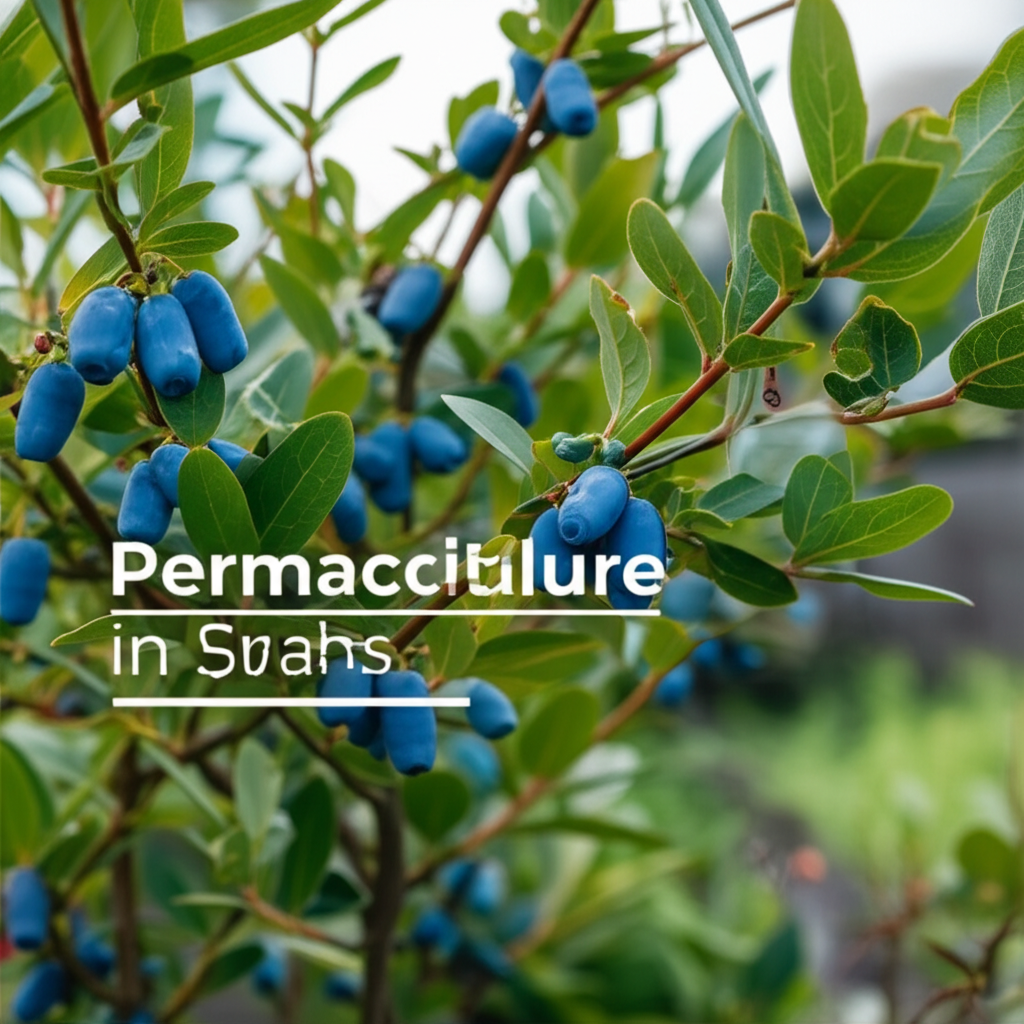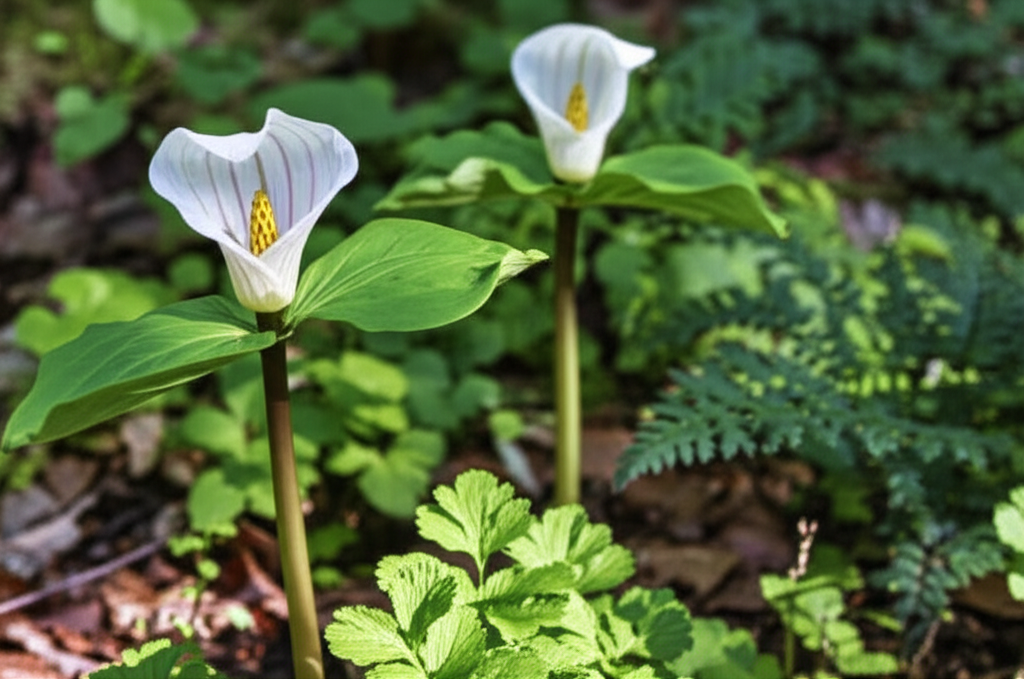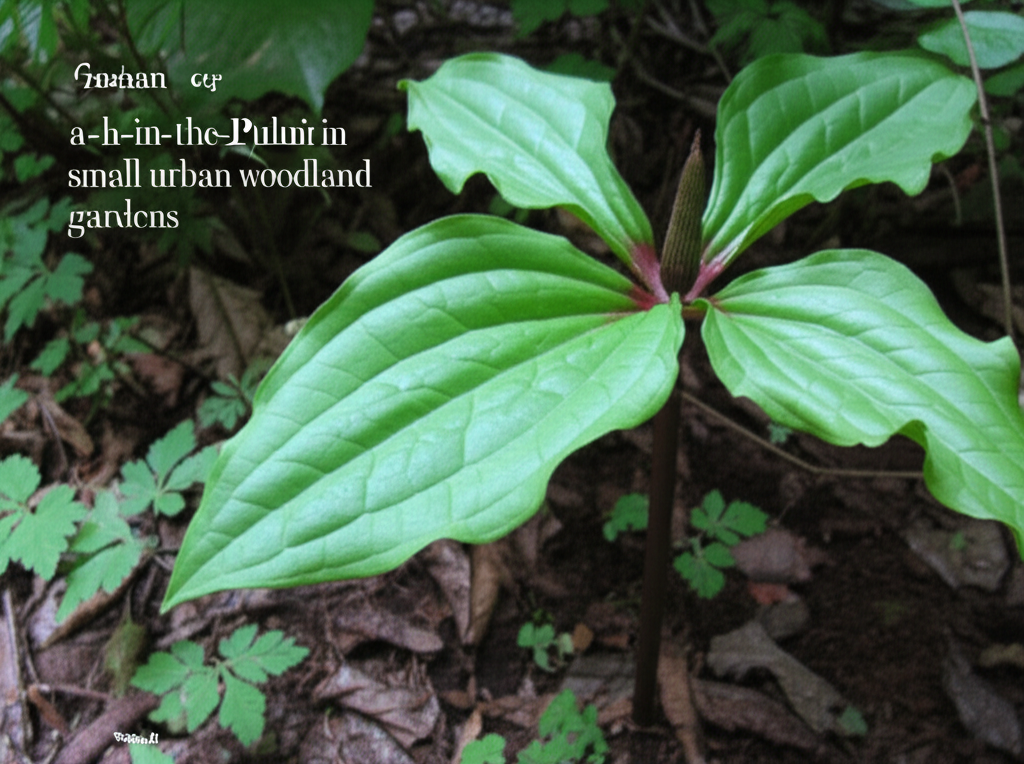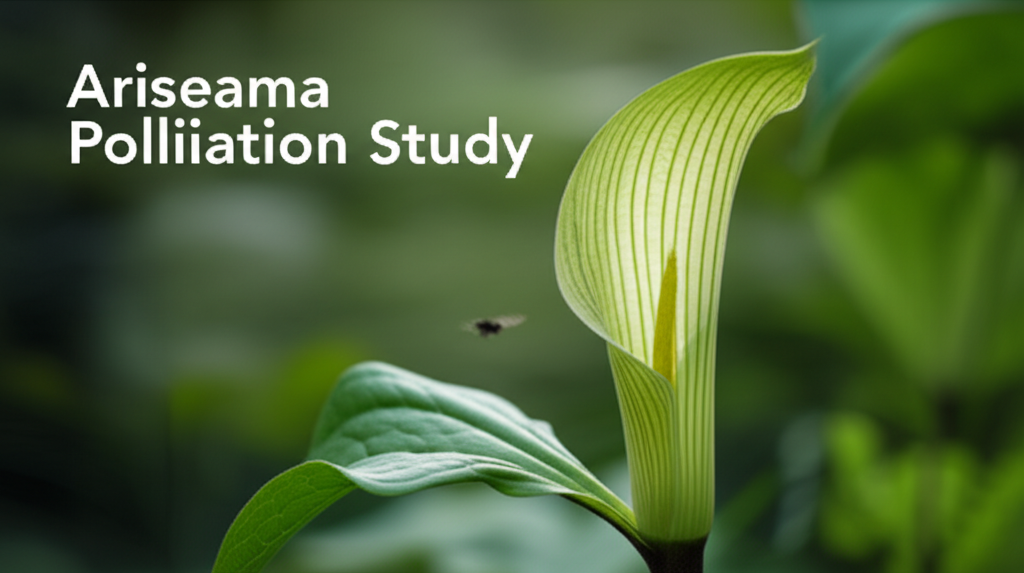Introduction to the Honeyberry Shrub in Permaculture
The concept of permaculture, a system of agricultural and social design principles centered on simulating or directly utilizing the patterns and features observed in natural ecosystems, thrives on the selection of resilient, multifunctional plants. Among the many valuable additions to a permaculture garden, the honeyberry shrub (also known as Haskap or Lonicera caerulea) stands out as a truly exceptional choice. This hardy, adaptable, and incredibly productive berry bush offers a wealth of benefits, making it a cornerstone for sustainable food systems.
From its early spring blooms to its late summer harvest of antioxidant-rich berries, the honeyberry integrates seamlessly into diverse permaculture designs. Its nitrogen-fixing capabilities, ability to tolerate a wide range of soil conditions, and resistance to pests and diseases contribute to a lower-maintenance and more robust garden ecosystem. This article will delve into the multifaceted advantages of incorporating honeyberry shrubs into your permaculture landscape, exploring its cultivation, ecological benefits, and culinary uses.
Understanding the Honeyberry (Haskap): Botanical Aspects and Varieties
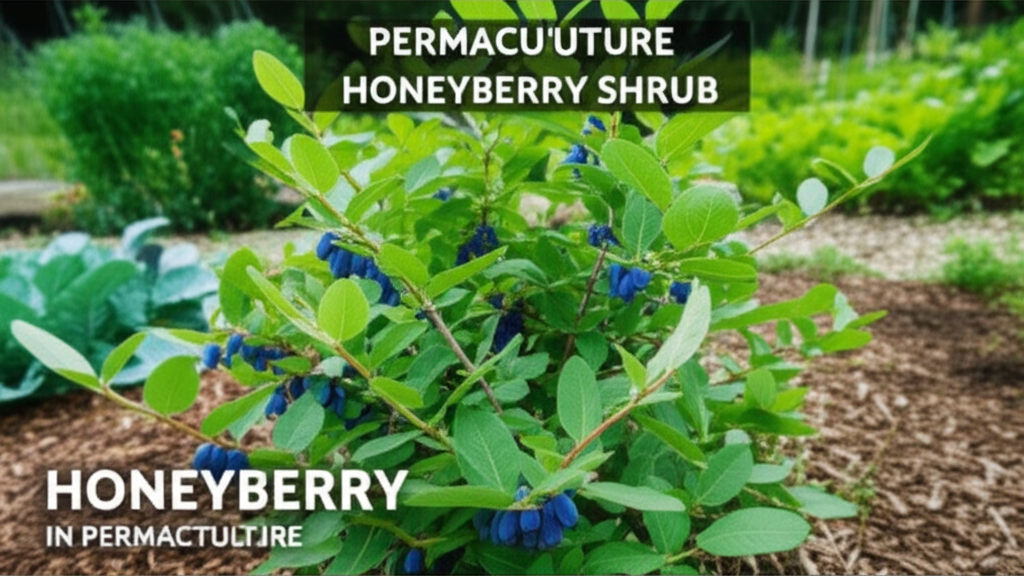
The honeyberry, scientifically known as Lonicera caerulea, is a deciduous shrub native to the boreal forest regions of the Northern Hemisphere, including parts of Canada, Russia, and Japan. Its common names, Haskap and Honeyberry, both allude to the unique flavor and sweetness of its fruit. The name “Haskap” originates from the Ainu language, meaning “gift of the buds of the tree.”
Key Botanical Characteristics:
- Growth Habit: Honeyberries are typically upright, spreading shrubs that can reach heights of 4 to 6 feet (1.2 to 1.8 meters) and a similar width.
- Foliage: The leaves are ovate to oblong, about 1 to 3 inches long, and have a bluish-green hue, often with a slightly fuzzy texture.
- Flowering: The plant produces small, tubular, pale yellow to white flowers in early to mid-spring, often blooming before or alongside the foliage. These flowers are crucial for pollination.
- Fruiting: The berries are elongated, oval, or oblong, typically measuring 1/2 to 1 inch in length. Their color ranges from deep blue to purple, often with a powdery bloom. The flavor is a unique blend of tart and sweet, often described as a cross between blueberries, raspberries, and blackcurrants.
- Hardiness: Honeyberries are exceptionally cold-hardy, tolerating temperatures down to -40°F (-40°C) or even lower, making them ideal for colder climates where many other fruit bushes struggle.
- Pollination: Honeyberries require cross-pollination to produce a good yield. Planting at least two different varieties that bloom at the same time is essential.
Popular Honeyberry Varieties for Permaculture:
Selecting the right varieties is crucial for maximizing yield and flavor. Many cultivars have been developed with specific characteristics in mind.
| Variety Name | Origin | Berry Size & Shape | Flavor Profile | Ripening Time | Additional Notes |
|---|---|---|---|---|---|
| Aurora | Canada | Large, oblong | Sweet, slightly tart, blueberry-like | Mid-late season | Good producer, disease resistant |
| Borealis | Canada | Medium, oblong | Sweet, slightly tart, raspberry notes | Early-mid season | Good pollinator for other Canadian varieties |
| Honey Bee | Canada | Medium, oblong | Sweet, tangy, complex | Early-mid season | Excellent pollinator |
| Indigo Gem | Canada | Medium, oblong | Sweet, mild, hint of cherry | Mid-season | More upright growth habit |
| Tundra | Canada | Medium, oblong | Tart, blueberry-like | Early season | Very cold hardy, good for colder regions |
| Vostorg | Russia | Medium, oval | Sweet, tart, musky | Early season | Known for vigorous growth |
| Nimble | Russia | Small to medium, oblong | Sweet, juicy | Early season | More compact growth |
Permaculture Principles and Honeyberry Integration
The honeyberry shrub aligns perfectly with core permaculture principles, offering a synergistic contribution to a thriving, self-sustaining garden system.
Key Permaculture Principles Addressed by Honeyberry:
- Observe and Interact: Understanding the honeyberry’s growth habits, pollination needs, and preferred conditions allows for optimal placement and management within the garden.
- Catch and Store Energy: The shrub captures solar energy through photosynthesis, storing it in its fruits, which are then harvested and consumed or preserved.
- Obtain a Yield: The primary function is to provide a nutritious and delicious fruit harvest, contributing to food security.
- Apply Self-Regulation and Accept Feedback: The plant’s natural resilience and resistance to pests and diseases demonstrate its ability to self-regulate, requiring minimal external intervention.
- Use and Value Renewable Resources and Services: Honeyberries utilize sunlight, water, and nutrients from the soil, acting as a renewable food source.
- Produce No Waste: All parts of the plant can be utilized, from the berries for consumption to the prunings for mulch or compost.
- Design from Patterns to Details: Understanding the plant’s growth patterns and its role in the larger ecosystem guides its integration into the garden design.
- Integrate Rather than Segregate: Honeyberries can be integrated into various polyculture systems, supporting other plants and animals.
- Use Small and Slow Solutions: The shrub’s steady growth and predictable yield represent a sustainable, low-input food production method.
- Use and Value Diversity: Incorporating multiple honeyberry varieties enhances pollination, resilience, and the overall biodiversity of the garden.
- Use Edges and Value the Marginal: Honeyberries can thrive in less-than-ideal soil conditions or on the edges of garden beds, making use of marginal spaces.
- Creatively Use and Respond to Change: The shrub’s adaptability to varying climates and its early fruiting make it a reliable component in a changing environment.
Functional Roles in a Permaculture System:
- Food Production: The primary role is the production of nutritious berries.
- Nitrogen Fixation: While not as significant as legumes, some Lonicera species can fix atmospheric nitrogen, enriching the soil. This makes them excellent companion plants for other species that may require nitrogen.
- Pollinator Attraction: The early spring flowers provide a crucial nectar source for early-emerging pollinators like bees, supporting the broader garden ecosystem.
- Wildlife Habitat: The dense growth habit offers shelter for small birds and beneficial insects.
- Erosion Control: The root system helps stabilize soil on slopes and banks.
- Windbreak: Planted in rows, honeyberries can act as a low windbreak, protecting more delicate plants.
- Pest Deterrence: Some anecdotal evidence suggests their presence can deter certain garden pests, though this is not a primary function.
Cultivation and Care for Honeyberry Shrubs
Cultivating honeyberries is remarkably straightforward, making them an excellent choice for both novice and experienced gardeners. Their low-maintenance nature aligns perfectly with permaculture’s emphasis on working with nature rather than against it.
Site Selection:
- Sunlight: Honeyberries prefer full sun but can tolerate partial shade. For optimal fruit production, at least 6-8 hours of direct sunlight per day is recommended.
- Soil: They are highly adaptable and can grow in a wide range of soil types, from sandy loam to heavier clay. However, they thrive in well-drained soil with a slightly acidic to neutral pH (5.5-7.0). Avoid waterlogged areas.
- Wind Exposure: While they can tolerate wind, planting them in a location with some protection from harsh winds can be beneficial, especially during flowering.
Planting:
- Timing: The best time to plant honeyberry shrubs is in early spring or fall, when the plants are dormant.
- Spacing: Space plants 4-6 feet apart to allow for mature growth and adequate air circulation. For hedgerows or windbreaks, closer spacing (3-4 feet) can be used.
- Preparation: Dig a hole twice as wide and as deep as the plant’s root ball. Amend the soil with compost or well-rotted manure to improve fertility and drainage.
- Planting Depth: Plant the shrub at the same depth it was in its nursery container. Ensure the graft union (if present) is above the soil line.
- Watering: Water thoroughly after planting to settle the soil and eliminate air pockets.
Ongoing Care:
- Watering: Water regularly during the first year to establish the root system. Once established, honeyberries are relatively drought-tolerant, but supplemental watering during dry periods will improve fruit production.
- Mulching: Apply a layer of organic mulch (wood chips, straw, compost) around the base of the plant to retain soil moisture, suppress weeds, and regulate soil temperature.
- Fertilizing: Honeyberries generally do not require heavy fertilization. A light application of compost or a balanced organic fertilizer in early spring is usually sufficient. Over-fertilizing, especially with nitrogen, can lead to excessive foliage growth at the expense of fruit.
- Pruning: Pruning is important for maintaining plant health, shape, and productivity.
- Young Plants (First 2-3 years): Focus on establishing a strong framework by removing any weak, crossing, or inward-growing branches.
- Mature Plants: Prune annually in late winter or early spring, before new growth begins. Remove old, unproductive wood (thicker, gray branches), any dead or diseased branches, and branches that are crossing or rubbing. Aim to open up the center of the shrub to improve air circulation and light penetration. Thin out up to one-third of the oldest branches each year to encourage new growth.
- Pest and Disease Management: Honeyberries are remarkably resistant to most common pests and diseases. Their natural resilience means that chemical interventions are rarely necessary in a well-designed permaculture system. Aphids can occasionally be a minor issue, but ladybugs and other beneficial insects often keep them in check.
Ecological Benefits and Biodiversity Enhancement
The integration of honeyberry shrubs extends far beyond simple fruit production, offering significant ecological advantages within a permaculture landscape.
Supporting Pollinators:
The honeyberry’s early spring blossoms are a vital resource for emerging pollinators at a time when many other flowering plants have not yet begun to bloom. This early nectar and pollen source is crucial for the survival and activity of bees, hoverflies, and other beneficial insects. By providing this early food, honeyberries contribute to the overall health and productivity of the garden’s pollinator population, which in turn benefits other fruiting plants.
Habitat and Food for Wildlife:
The dense growth habit of honeyberry shrubs provides excellent shelter and nesting sites for various small birds and beneficial insects. While the berries are primarily for human consumption, any dropped fruit can also serve as a food source for ground-dwelling birds or small mammals.
Soil Improvement:
As mentioned, some Lonicera species possess nitrogen-fixing capabilities, subtly enriching the soil over time. Furthermore, the natural shedding of leaves and organic matter from the shrub contributes to the soil’s organic content, improving its structure, water retention, and nutrient availability. This reduces the need for external soil amendments.
Reduced Need for Inputs:
The inherent hardiness and disease resistance of honeyberries mean that they require minimal inputs of water, fertilizers, or pesticides. This aligns perfectly with permaculture’s goal of creating low-input, sustainable systems that work in harmony with natural processes.
Culinary Uses and Nutritional Value
The taste and versatility of honeyberries make them a delightful addition to any kitchen, offering a unique flavor profile and a wealth of health benefits.
Flavor and Texture:
Honeyberries possess a distinctive flavor that is often described as a complex blend of tartness and sweetness, with notes reminiscent of blueberries, raspberries, blackcurrants, and even a hint of cherry. Their texture is typically firm, with a juicy interior.
Nutritional Powerhouse:
These small berries are packed with nutrients, making them a valuable component of a healthy diet.
| Nutrient | Honeyberry | Blueberry |
|---|---|---|
| Calories | 53 | 57 |
| Carbohydrates (g) | 12.1 | 14.5 |
| Fiber (g) | 2.6 | 2.4 |
| Sugars (g) | 8.9 | 10.0 |
| Fat (g) | 0.3 | 0.3 |
| Protein (g) | 0.9 | 0.7 |
| Vitamin C (mg) | 46 | 9.7 |
| Vitamin A (IU) | 55 | 54 |
| Manganese (mg) | 0.3 | 0.3 |
| Anthocyanins (mg) | Higher | High |
| Antioxidant Capacity (ORAC) | Very High | High |
Note: Nutritional values can vary based on variety and growing conditions.
Culinary Applications:
The uses for honeyberries are as varied as their flavor:
- Fresh Consumption: Simply pop them straight from the bush for a refreshing snack.
- Smoothies: Add a burst of flavor and nutrients to your morning smoothies.
- Jams and Jellies: Their natural pectin content makes them ideal for jams and jellies.
- Pies and Tarts: Use them in baked goods for a unique sweet-tart flavor.
- Sauces: Create delicious sauces for desserts or savory dishes.
- Juices: Process them into vibrant, healthy juices.
- Freezing: Honeyberries freeze exceptionally well, allowing you to enjoy their benefits year-round. Simply wash and freeze them in a single layer on a baking sheet before transferring to freezer bags.
Integrating Honeyberries into Polyculture Designs
The true power of the honeyberry in permaculture lies in its ability to be integrated into diverse polyculture systems, creating mutually beneficial relationships between plants and enhancing overall garden resilience.
Companion Planting:
Honeyberries can be planted alongside a variety of other plants:
- Berries: Pairing them with other berries like blueberries, raspberries, and currants can create a diverse and productive berry patch.
- Fruit Trees: Their early bloom can benefit fruit trees by attracting pollinators. They can also be planted as understory shrubs in young orchards.
- Nitrogen Fixers: Companion planting with nitrogen-fixing plants like lupins or clover can further enhance soil fertility.
- Herbs: Many herbs, such as mint, thyme, and lavender, can be planted around honeyberries to deter pests or attract beneficial insects.
Layered Planting Systems:
Honeyberries fit well into layered planting systems, occupying the mid-story layer between ground covers and taller shrubs or trees. This maximizes space utilization and creates a more biodiverse ecosystem.
Edible Landscaping:
Their attractive foliage, early spring flowers, and abundant blue berries make honeyberries an aesthetically pleasing as well as a productive addition to edible landscaping designs. They can be used as hedges, border plantings, or as specimen shrubs.
Food Forests:
Within a food forest system, honeyberries are ideal for the shrub layer, providing an early harvest of fruit and contributing to the overall ecological functions of the forest garden.
Challenges and Considerations
While honeyberries are remarkably easy to grow, a few considerations can help ensure success.
Pollination Requirements:
As previously mentioned, honeyberries require cross-pollination. Planting at least two different varieties with overlapping bloom times is essential for fruit set. Ensure your chosen varieties are compatible pollinators.
Deer and Bird Protection:
While generally hardy, young plants can be susceptible to deer browsing. Bird netting may be necessary to protect ripening berries from avian pests, especially if you have a significant bird population. However, their tartness can sometimes deter birds more than sweeter berries.
Ripening Time Variation:
The ripening time of honeyberries can vary depending on the variety, climate, and specific growing conditions. Monitoring your plants closely is important to harvest berries at their peak ripeness.
Berry Drop:
Some varieties may experience a slight “berry drop” if they are overripe or if there is excessive wind. Harvesting promptly can minimize this.
Conclusion: The Honeyberry as a Permaculture Staple
The honeyberry shrub is a truly remarkable plant for any permaculture enthusiast. Its exceptional hardiness, adaptability, early spring blossoms, antioxidant-rich fruits, and minimal care requirements make it an invaluable asset to sustainable food systems. By integrating honeyberries into your garden design, you not only gain a delicious and nutritious food source but also contribute to a more biodiverse, resilient, and ecologically sound landscape. As we strive to create gardens that are both productive and in harmony with nature, the honeyberry stands as a shining example of a plant that truly embodies the principles of permaculture. Its multifaceted benefits cement its place as a staple for anyone seeking to cultivate a thriving and sustainable edible ecosystem.
